Navigating the World of Cryotherapy: Understanding the Differences Between Electric and Nitrogen Methods for Wellness

Cryotherapy, offering numerous potential benefits for both physical and mental health, has gained popularity as a wellness practice in recent years. As interest in cryotherapy grows, so does the variety of methods available, with two cryotherapy emerging as prominent options. Understanding the differences between these methods is crucial for individuals seeking to incorporate cryotherapy into their wellness routines effectively. But which one is better, electric or nitrogen?
Electric cryotherapy, also known as electric-powered cryotherapy, involves using a machine that generates extremely cold air through an electric refrigeration system. This method allows for precise temperature control, typically ranging from -100°C to -140°C (-148°F to -220°F). During an electric cryotherapy session, individuals are exposed to this cold air for a short period, usually around 2-4 minutes.
Nitrogen cryotherapy, on the other hand, utilizes liquid nitrogen to create freezing temperatures. Liquid nitrogen, with a boiling point of -196°C (-321°F), is vaporized to produce a cold nitrogen gas environment. This method often involves cryotherapy chambers or cryosaunas, where individuals are immersed in the nitrogen gas for a brief duration, typically lasting 2-3 minutes.
One of the primary differences between electric and nitrogen cryotherapy lies in the method of cold air generation. While electric cryotherapy relies on an electric refrigeration system, nitrogen cryotherapy harnesses the extreme cold produced by vaporizing liquid nitrogen. This variance in technology can impact factors such as temperature consistency, cooling efficiency, and overall user experience.
Temperature control is a critical aspect of cryotherapy, as precise cooling is essential for safety and effectiveness. Electric cryotherapy systems offer more precise temperature control compared to nitrogen cryotherapy, allowing for adjustments tailored to individual preferences and tolerance levels. On the other hand, nitrogen cryotherapy relies on the vaporization of liquid nitrogen, which may result in less precise temperature regulation, potentially leading to variations in cold exposure during sessions.
ALSO READ: Understanding the Benefits of Steroids for Health & Wellness
Furthermore, the cooling efficiency of each method may vary. Electric cryotherapy systems can achieve lower temperatures more rapidly, providing intense cold exposure within seconds. In contrast, nitrogen cryotherapy chambers may require a slightly longer time to reach the desired temperature, as the liquid nitrogen vaporizes to create the cold environment. However, once the chamber reaches the target temperature, nitrogen cryotherapy can offer consistent cooling throughout the session.
The user experience also differs between electric and nitrogen cryotherapy. Electric cryotherapy chambers often feature an open-top design, allowing individuals to stand comfortably during the session while their head remains outside the chamber. This open configuration may appeal to individuals who experience claustrophobia or discomfort in enclosed spaces. Conversely, nitrogen cryotherapy chambers typically enclose the entire body, providing a more immersive experience but potentially inducing feelings of confinement in some users.
Conclusion
Both electric and nitrogen cryotherapy methods offer unique benefits for wellness, but understanding their differences is crucial for selecting the most suitable option. Electric cryotherapy provides precise temperature control and rapid cooling, while nitrogen cryotherapy offers consistent cold exposure and immersive chamber experiences. By navigating the world of cryotherapy with this knowledge, individuals can make informed decisions to optimize their wellness journeys.



